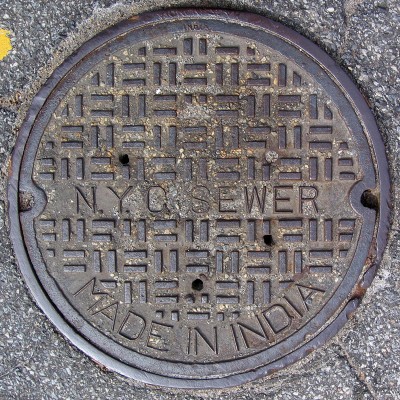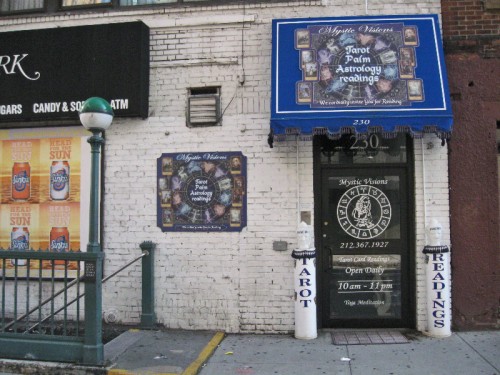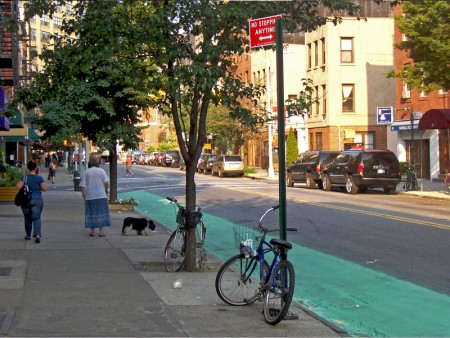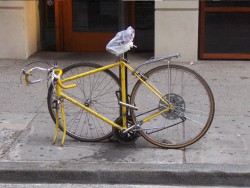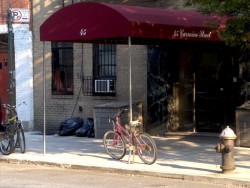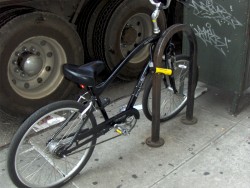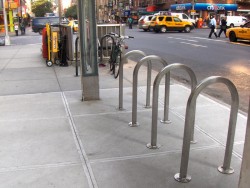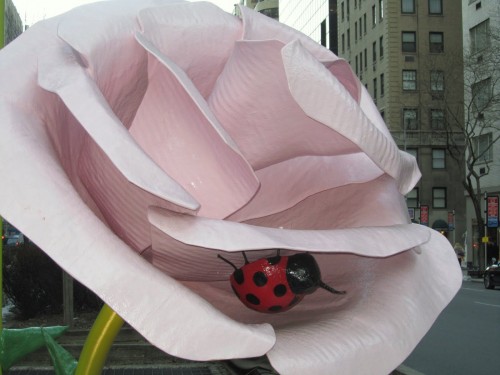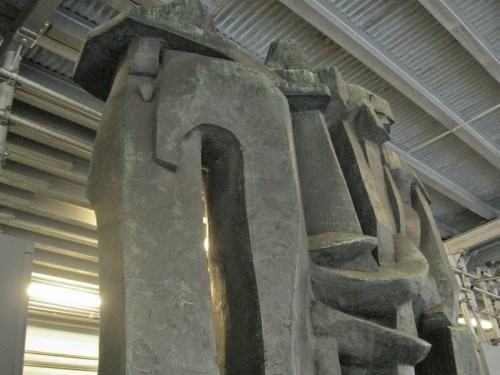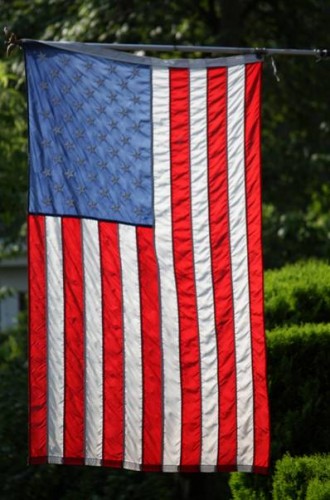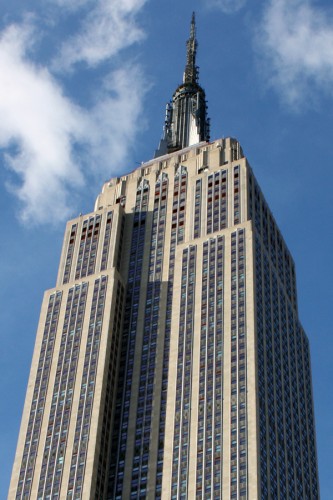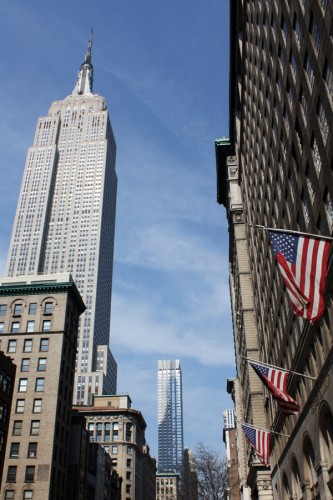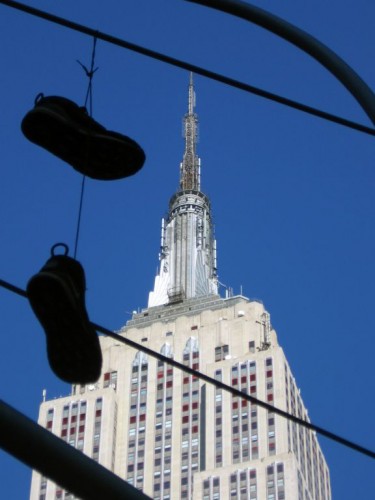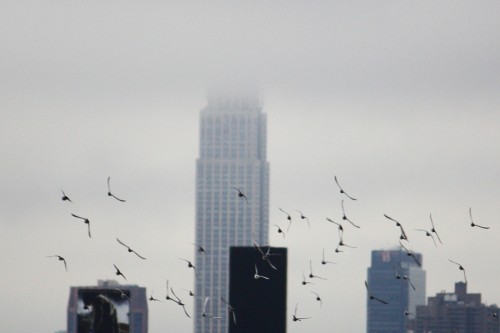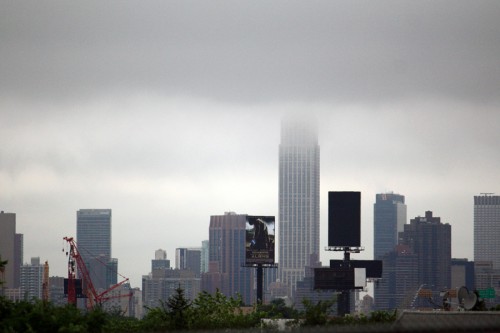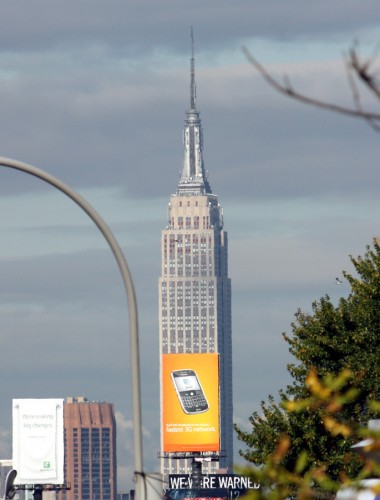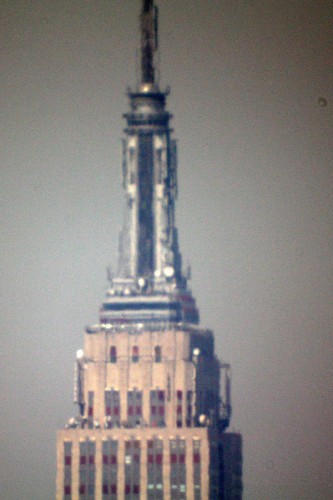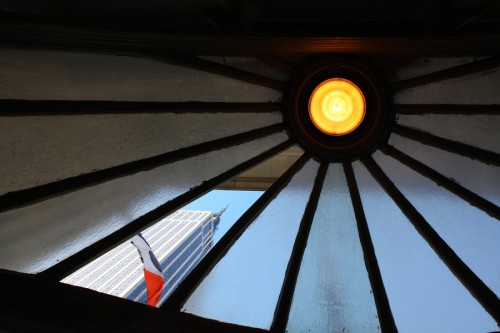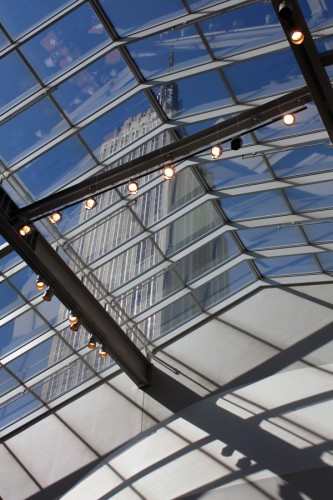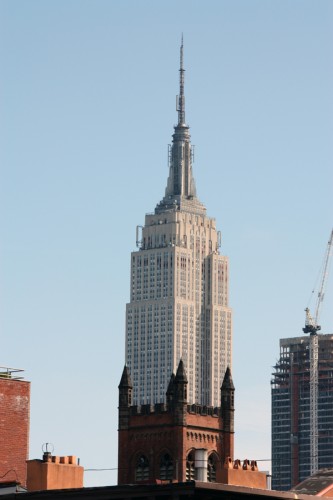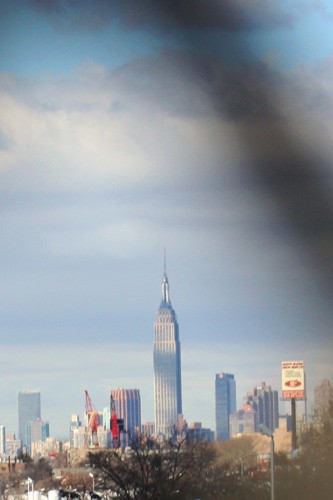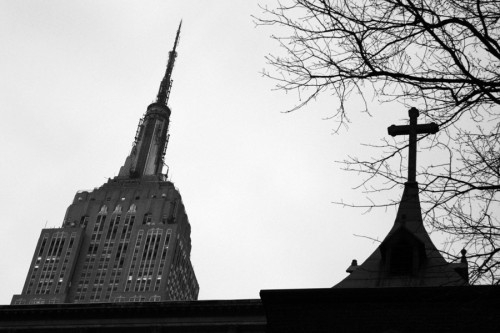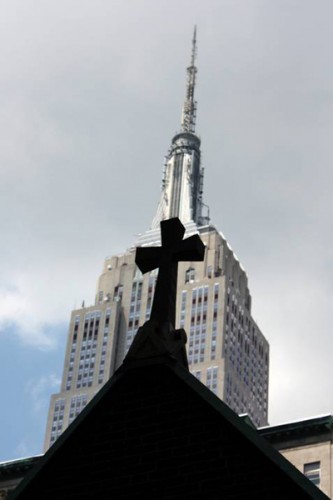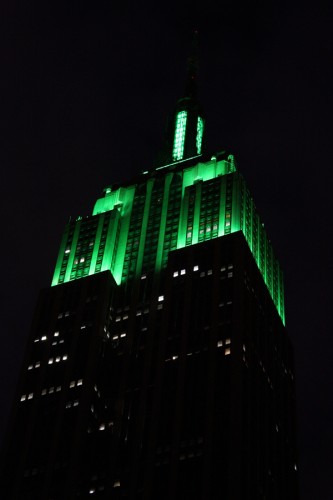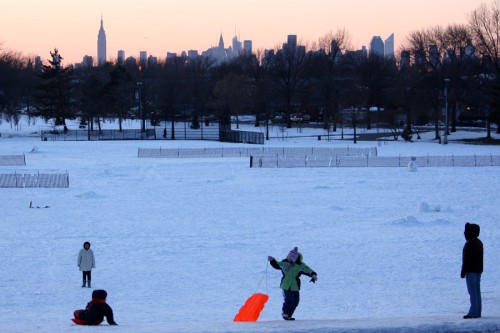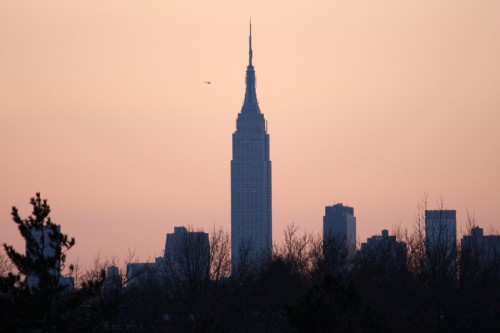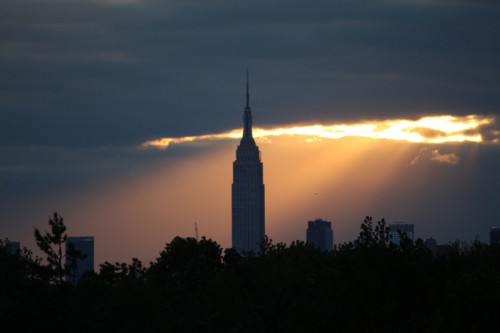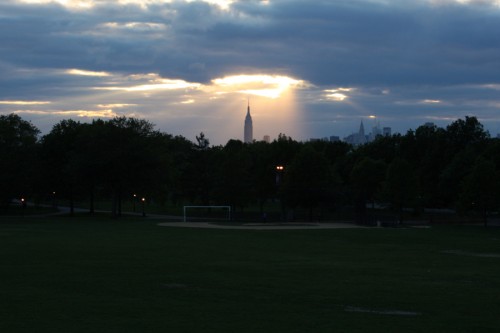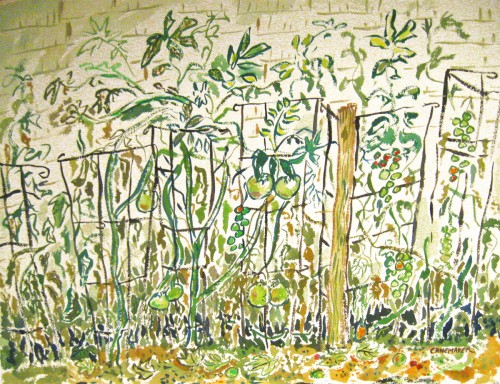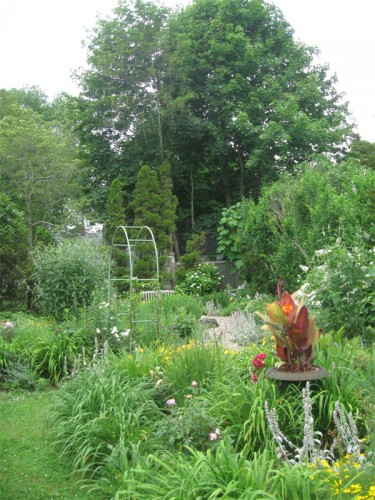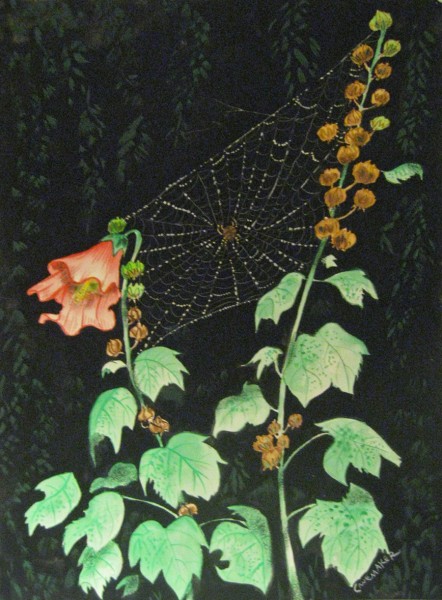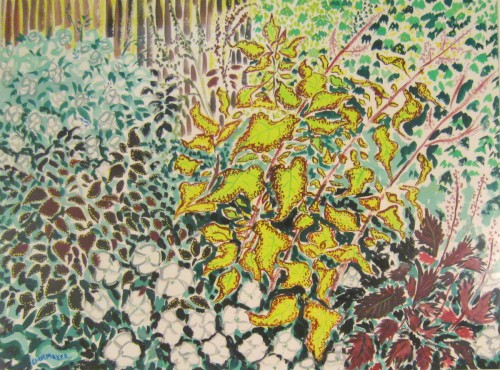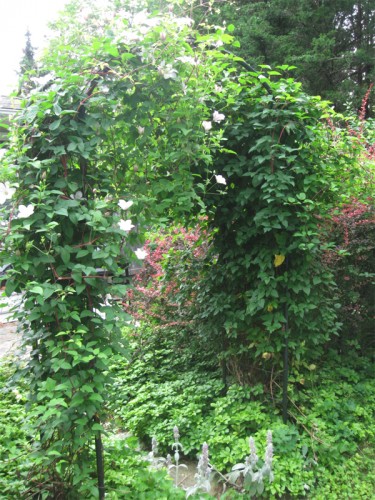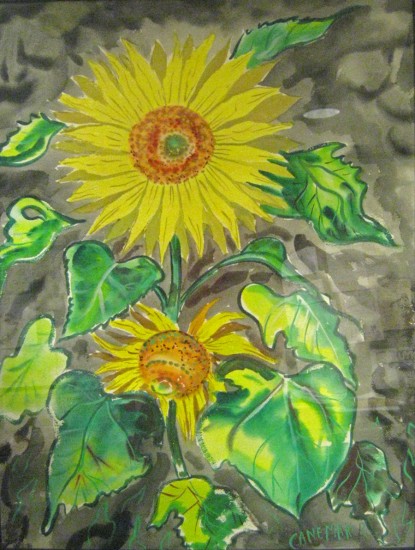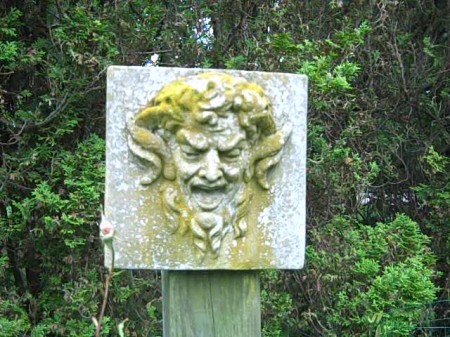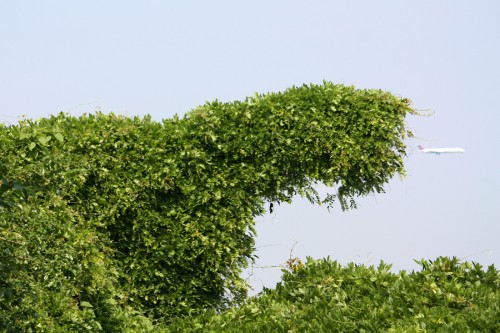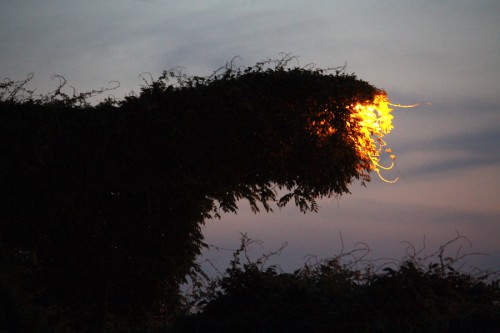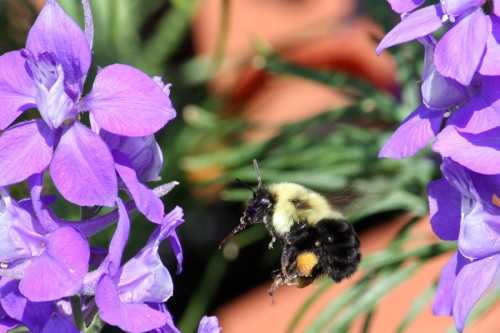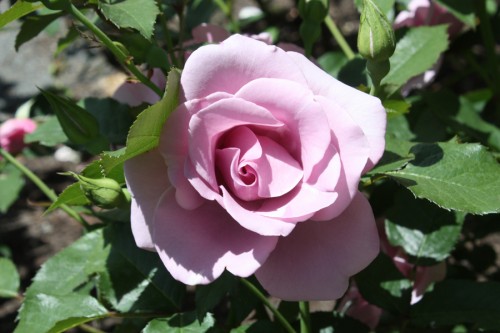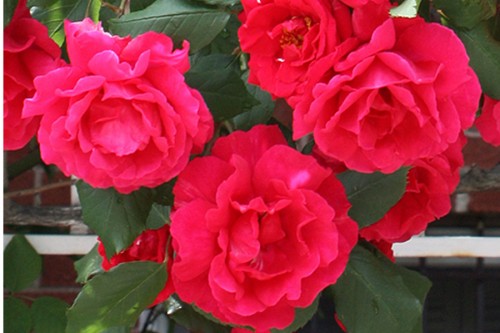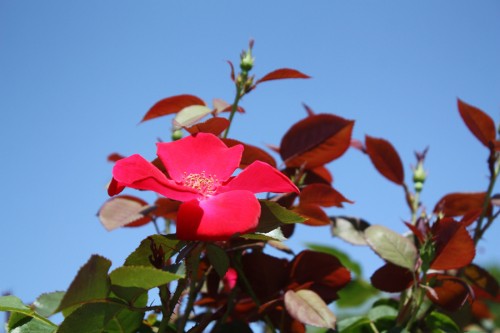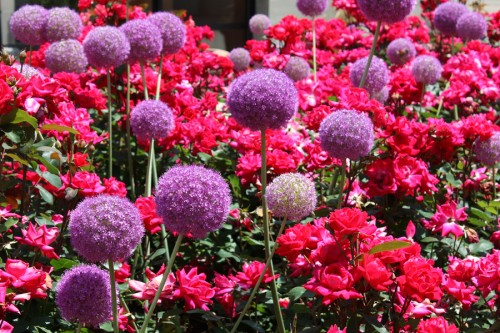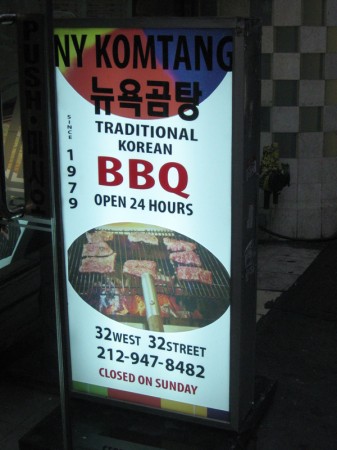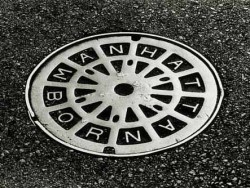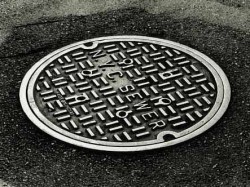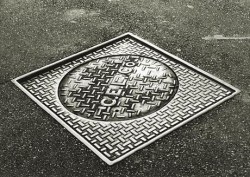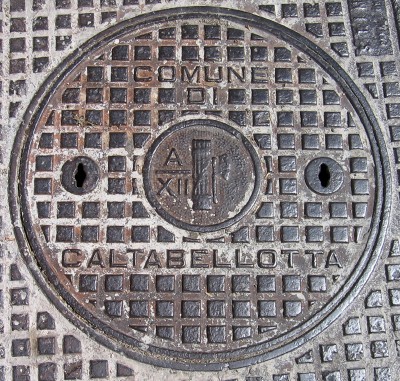Category ArchivePhotos
Photos 31 Jul 2011 07:25 am
2nd Floor Psychics
- As any follower of this blog knows, I am a fan of the thousands of Psychics that fill New York’s stores and streets. I have always been intrigued with them, and only when I’d read a New Yorker article about 12 years ago (I haven’t been able to relocate it) did I learn what those people were doing in there and how they were paying their rent. (Mostly selling crystals.)
Lately, all those storefront shops have been moving upstairs. I’m sure the rents are enormous for them to cover and available space is probably a problem. There seems to be a predilection, these days, for the Psychics to move on up to the 2nd floor of buildings. This means they have to get attention downstairs – passing out flyers, having big signs that you could trip over, and taking out cheap newspaper ads.
I photographed a few of these 2nd floor psychics and present them here.
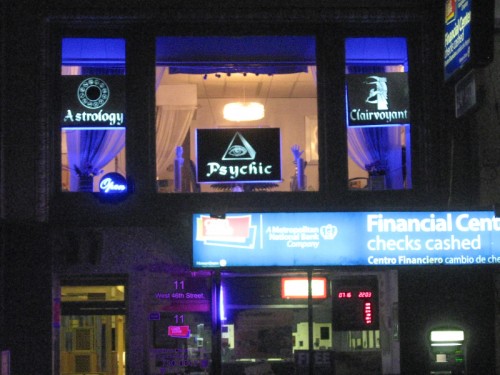 1
1This is one store I noticed up on 46th Street as I was coming home from the theater.
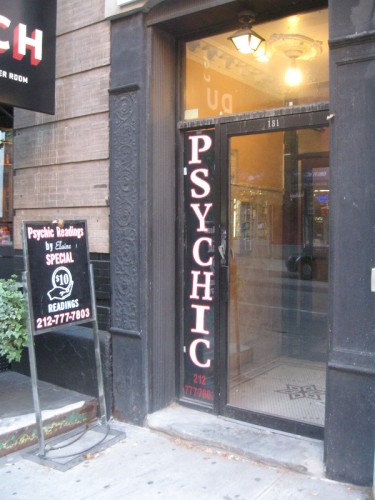 2
2
This is all that can be seen of one I shot on Prince Street a couple of weeks ago.
Upstairs are apartment windows. It’s not a commercial space.
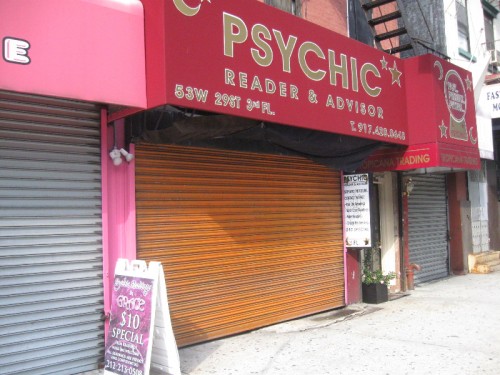 3
3
This is the entrance to one on 29th Street and Sixth Avenue.
I’ve never seen the street floor open.
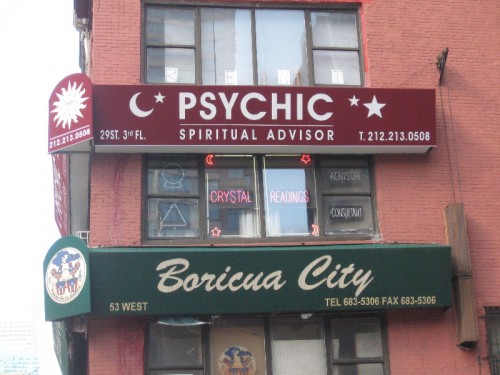 3
3
Here’s the upstairs store of the 29th Street Psychic.
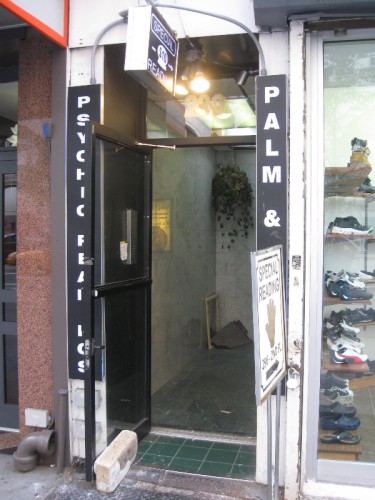 4
4
This is the entrance to a shop on Fifth Avenue and 30th Street.
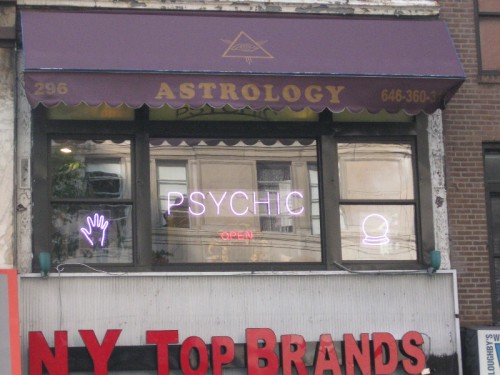 5
5
It leads upstairs to this shop.
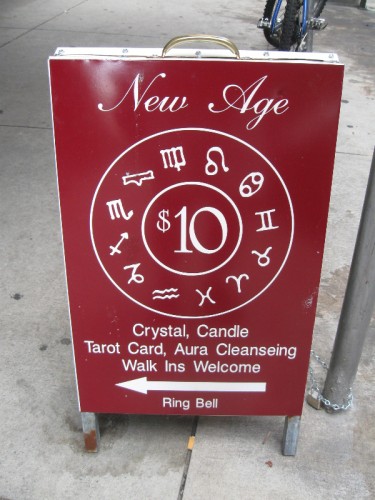 6
6
This sign greets you on 29th Street and Lexington Avenue.
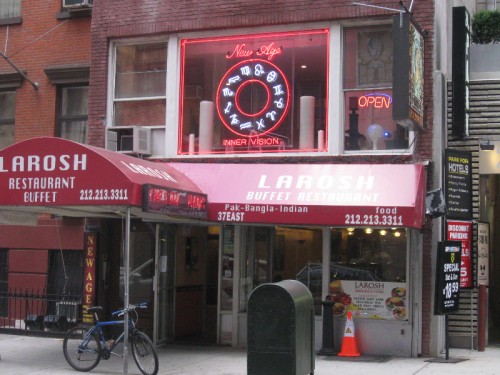 7
7
Upstairs they’ve designed it to look like the street floor restaurant
is part of the business. The place just looks huge.
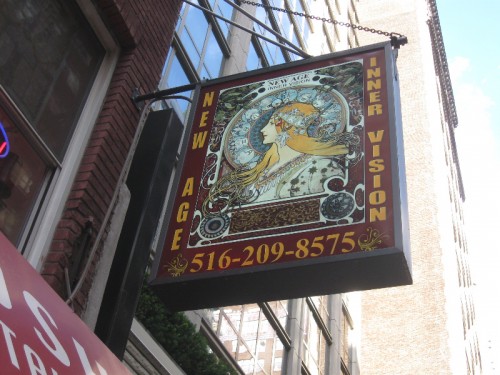 8
8
Here’s their upstairs sign which I find very attractive.
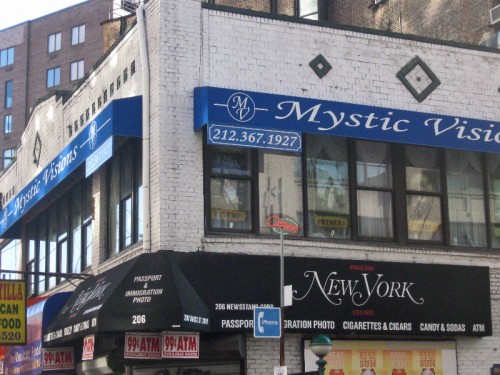 9
9
This is actually the first of the 2nd floor psychics that I noticed. About five years ago.
It’s located on Varick (Seventh Ave.) and Houston Street. A busy street corner in Soho.
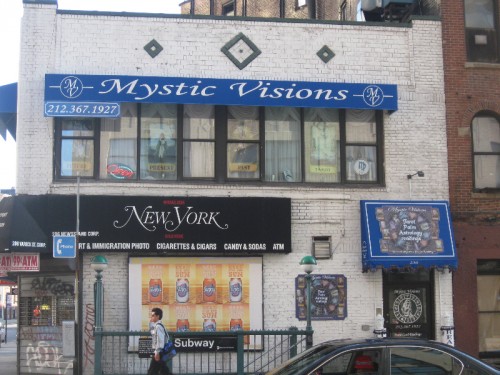 10
10
Though, in fact, I didn’t really notice that it was a Psychic’s shop.
I saw the blue, and I read the “Mystic Visions” but I never put two and two together.
There are quite a few others. You just have to keep looking up.
Photos 24 Jul 2011 06:50 am
There Goes the Neighborhood Photos
- The artists are always there first. In NYC, they settled in the 60s in Soho, just south of Greenwich Village where lots of warehouses & factories stood. Lots of galleries built around them, and the rents suddenly went high. The artists moved to Williamsburg in Brooklyn (just across the East River), a Polish neighborhood where the rents were low. Galleries and boutiques moved in, and the artists had to move out again. They went further into Brooklyn.
At 6am the other day, I was walking across Prince Street in Soho. It’s been years since the artists had fled, yet I realized a lot was still changing. Even bigger money was moving in, and the beauty and charm of the neighborhood was moving out. I took some photos and am about to give you a little tour.
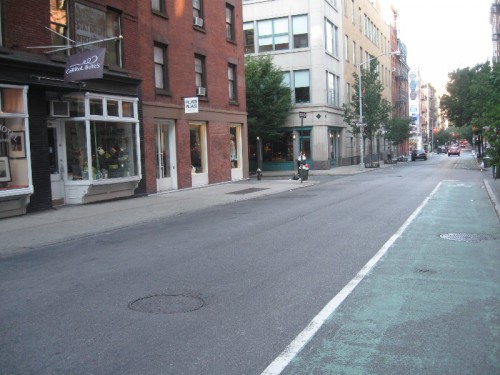 1
1This is Prince Street which goes across Manhattan Island from East to West.
In this photo I’m looking West because that’s the direction I’m walking.
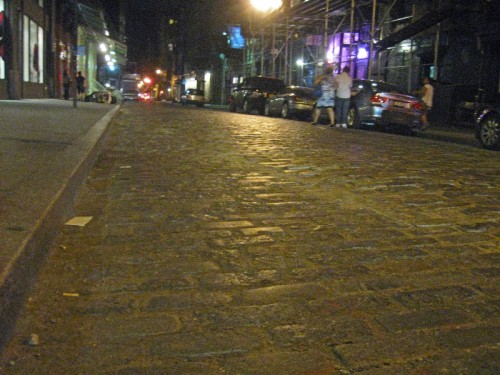 2
2
This is the first N/S street we come upon, Mercer Street looking North.
I was also there at midnight, so some of the pictures were shot at night.
You’ll notice it’s not really cobblestone but bricks laid to make up the street.
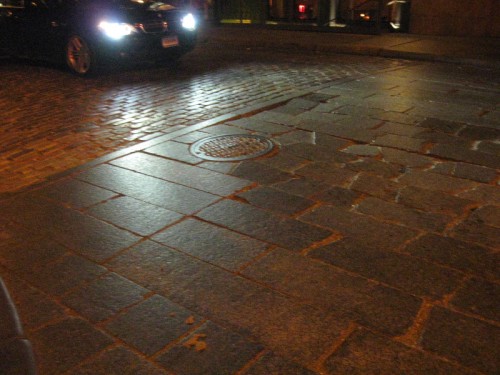 3
3
Even the crosswalk at Mercer Street is made of a different size brick.
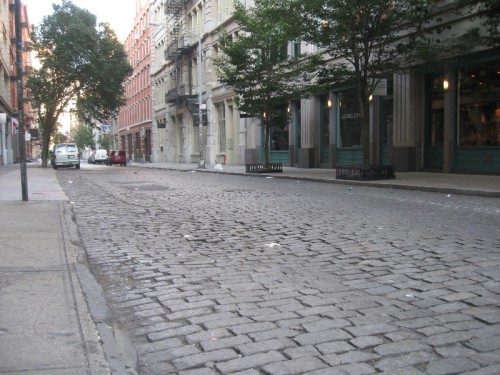 4
4
Here’s the next block, Wooster Street looking North.
The same brick composition poses as cobblestone.
It has its own sort of charm.
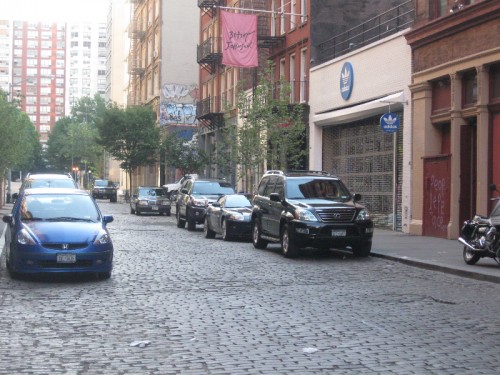 5
5
Here’s Wooster Street looking South.
More bricks, very quaint.
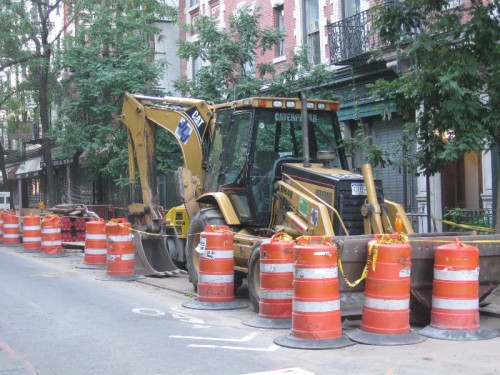 6
6
Aha! Construction has moved in, Greene Street, the next block up.
Those fake cobllestones will soon be history. Paved over.
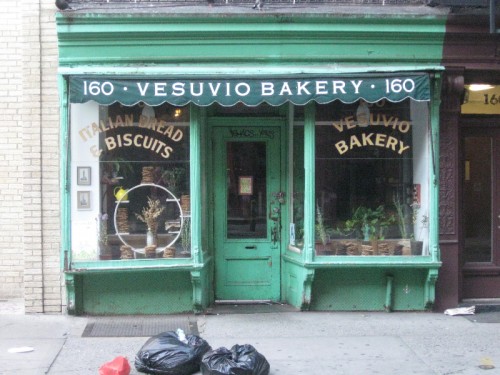 7
7
This is Vesuvio Bakery on Prince Street.
It’s a famous old bakery that sells great bread.
I wonder how long it’ll last.
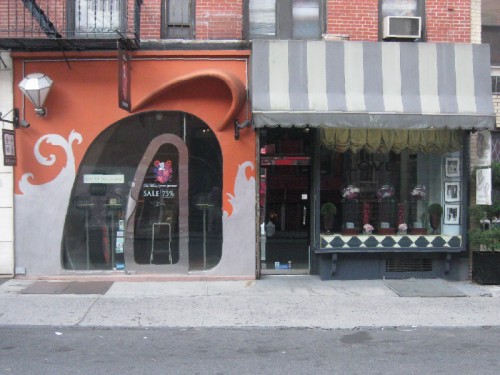 8
8
Right next door is a more fashionable Estate Jewelry store on Prince Street.
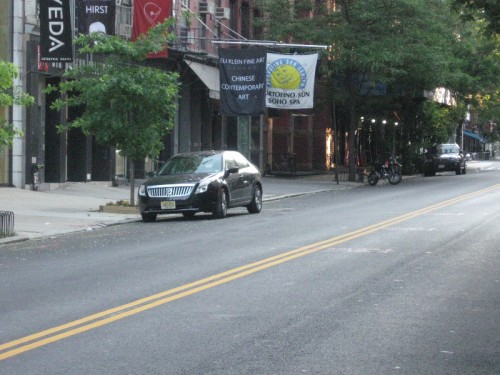 9
9
Once you get to West Broadway, everything changes.
The streets are paved the stores are chi-chi.
Traffic is two-way.
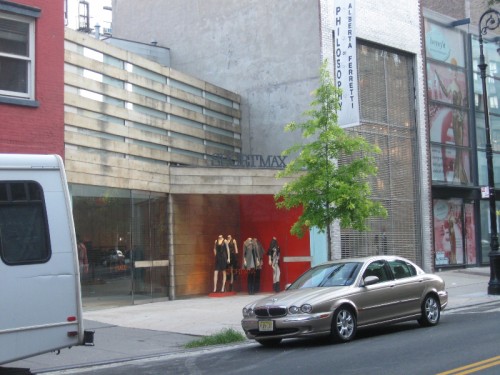 10
10
Here’s a fancy new store on West Broadway, a SportMax.
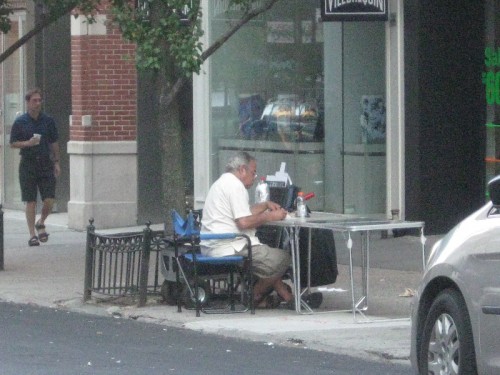 11
11
Street sellers line West Broadway selling their wares.
They have to fight the City even after they get their licenses.
(This was an all-out war under Giuliani – cops vs vendors.)
At 6am this is the first vendor to set up, just off Prince Street.
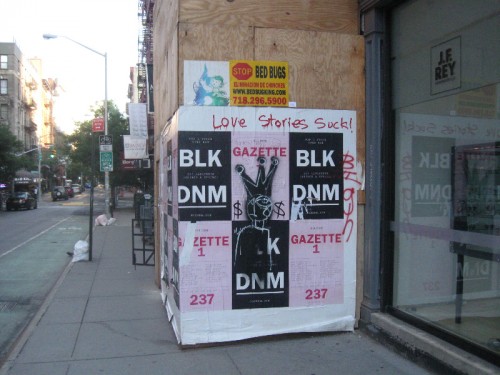 12
12
Even the construction sites look fancy on West Broadway.
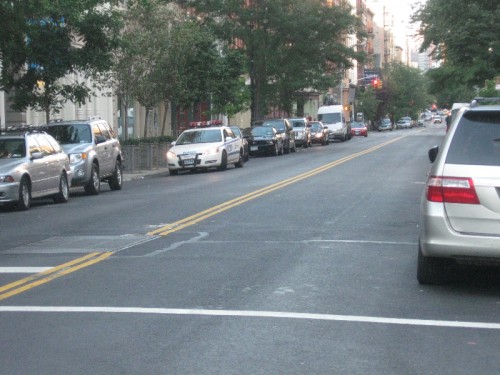 13
13
Here’s the last stop, the other end of Prince Street,
Sixth Avenue, looking back, East.
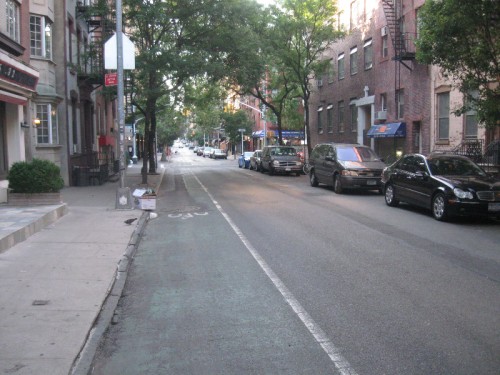 14
14
Moving down Sullivan Street (the last small cross street) heading Uptown.
It’s the very last block prior to Sixth Avenue.
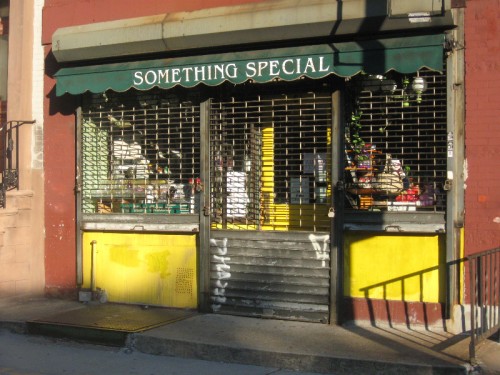 15
15
On of my favorite stores on Sullivan Street is Something Special.
It’s a candy store with a lot of rental Postal boxes. The pictures
of Matthew Broderick and Sarah Jessica Parker & their kids indicate
that the couple uses one of the boxes in this store. Their mail drop.
I get things notarized here from an older Italian gentleman.
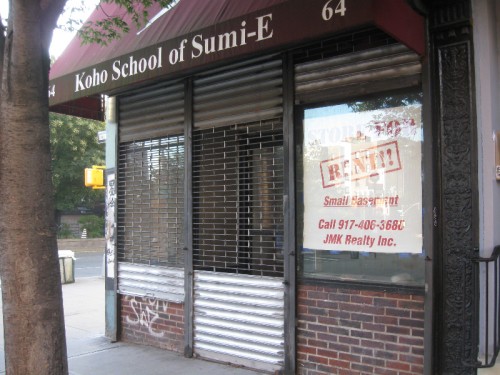 16
16
The Koho School of Sumi-E is going out of business on the corner
of Sullivan Street and Houston. This shop always reminds me of
the late Francis Lee, who studie Sumi-E painting.
He was a real Independent back in the day.
I often rented his Oxberry to shoot films overnight.
I wonder if the demise of this shop will mean that I won’t think so often of Francis.
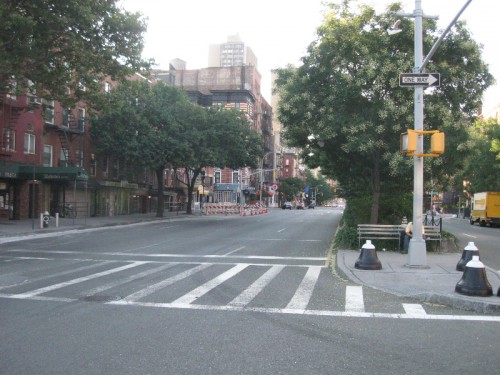 17
17
Here’s the big street that runs parallel to Prince Street. Houston Street looking East.
The photo shows one half of the traffic, so it’s a big street and separates NOHO from SOHO.
You can see that the nature of the neighborhood is changing. Brick-laid cobblestone is about to go completely. Old shops are being forced out of business, and money is moving in with higher prices and no concern for the little guy or the neighborhood. There are no artists here anymore, just vendors who pay high rents.
Photos &repeated posts 17 Jul 2011 07:27 am
recap Sunday – Hitching Posts
This post was produced back in July of 2008. I was looking at these bicycle posts again this week thinking of doing a follow-up. The images seemed identical, except that there was more loose garbage strewn on the street. I decided to just recap this original.
.
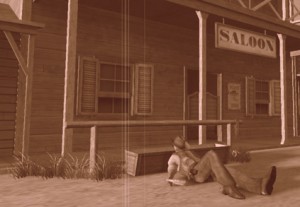 - Back in the wild, wild west, they used to have hitching posts so cowboys could tie their horses outside the local tavern to keep them from running wild. If there was no hitching post, cowboys in movies used the stanchions in front of the saloon or store.
- Back in the wild, wild west, they used to have hitching posts so cowboys could tie their horses outside the local tavern to keep them from running wild. If there was no hitching post, cowboys in movies used the stanchions in front of the saloon or store.
We don’t have horses in the big city, but we do have bicycles. Hitching these with chains and locks and anything to try to prevent theft has
________(Click any image to enlarge.)_____________been a primary difficulty for
_______________________________________-_____messengers and other bike riders.
My studio has two entrances (or exits depending on how you view the situation.) At both, there are wrought iron fences which sort of act as bannisters going up/down the steps. Leaving work the other day, I noticed that the back entrance was used as a “hitching post” for a couple of bike riders. Presumably they were working out in the gym just next door.
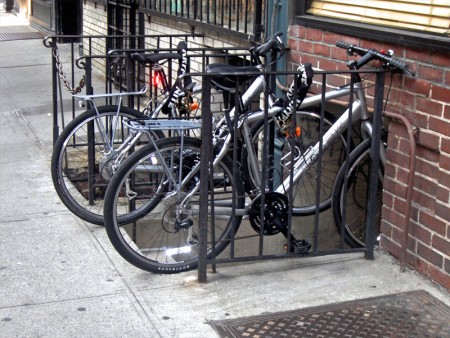
Good thing we rarely use this exit.
This made me start looking at other hitching posts I could find on my way home, and I took some snaps.
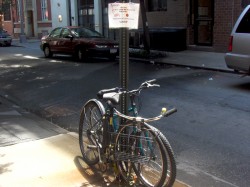
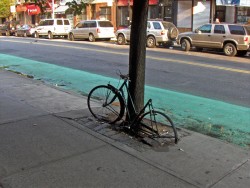
Sign posts and trees seem to be likely candidates.
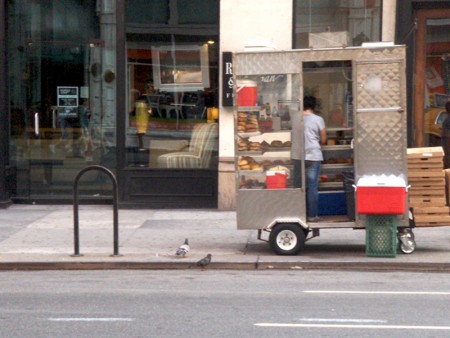
The upside-down “U” seems to be designed for smaller businesses
that want something curbside.
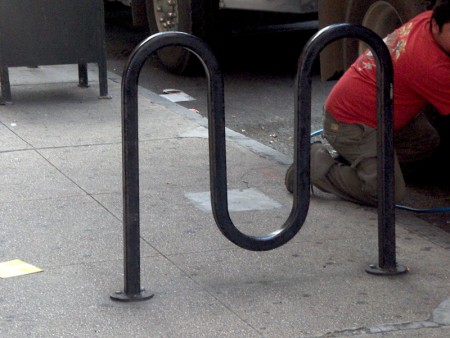
There’s also the “M” shape for a couple of bikes.
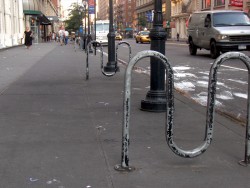
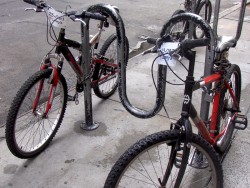
I’m not sure if these are supplied by the City or the storeowner.
There’s a uniformity around town that makes me wonder.
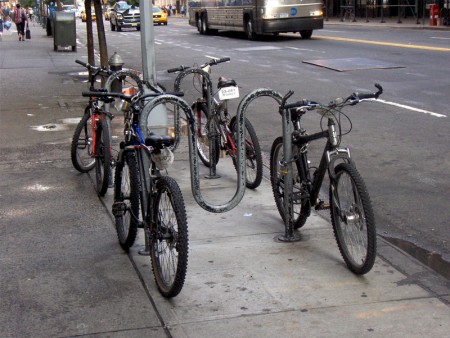
In places there are a number of these for the high bike traffic.
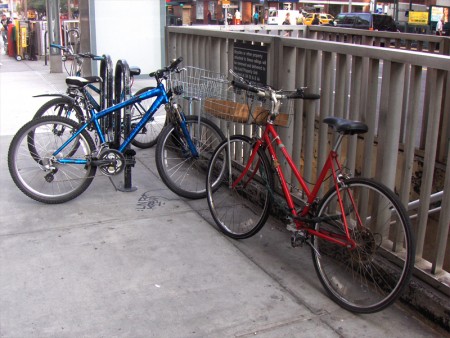
Sometimes this isn’t enough and a subway entrance serves as a backup.
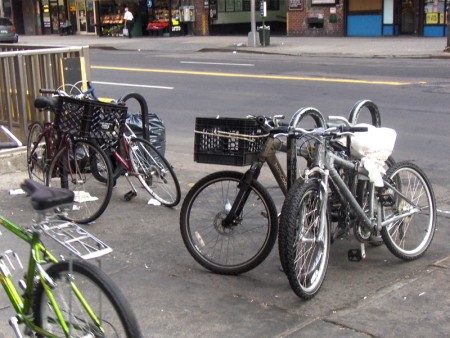
Even though many “M”s have been placed in the same area.
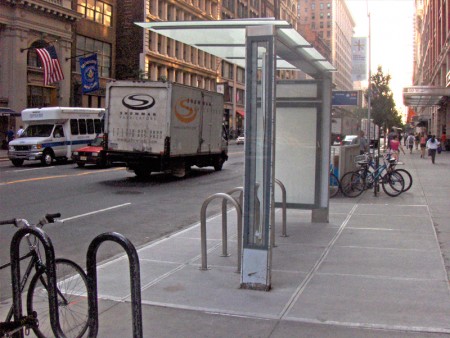
I did like noting this one unit outside a “Circuit City” store that offered
an overhead to protect the bikes outdoors.
Photos 10 Jul 2011 08:11 am
Outdoor Sculpture
- I like recording some of the outdoor sculpture I come upon in my travels around NY. And, for better or worse, I’m gonna share a couple of pieces with you here.
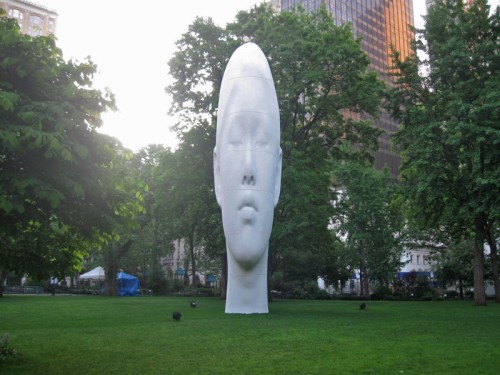 1
1Madison Square Park has had this enormous, Asian face on show in the “Great Field.”
It almost makes this photo feel as though it were a squeezed Cinemascope image.
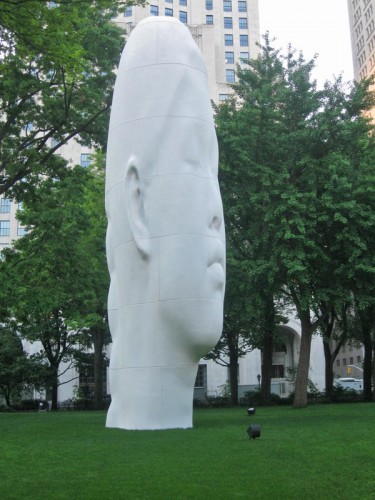 2
2
The luminescent quality of the stone makes me wonder
if anything is projected on this face at night.
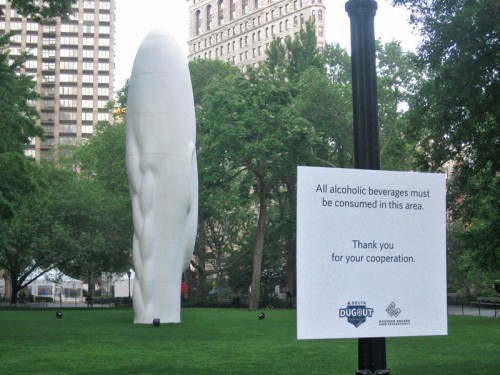 3
3
The sculptor, Jaume Plensa, created the 44′ face as an homage to “everyday people.”
The artist’s website states that the dream-like monolith “aims to introduce a quietness
to the park, allowing viewers a moment of serenity and reflection in the heart of the
city that never sleeps.â€
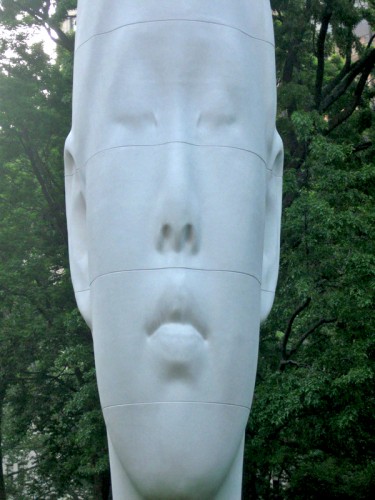 4
4
I love that the face is constructed in levels, like brickwork.
It’s actually white fiberglass coated with a gel.
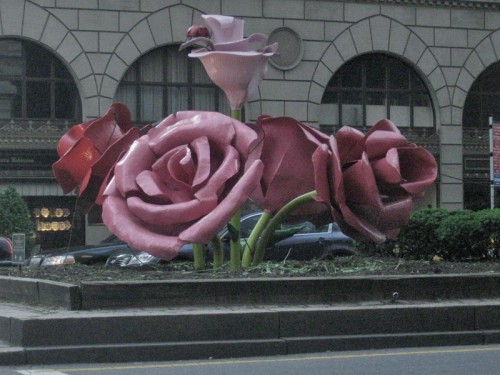 1
1
Moving up town to Park Avenue and 57th Street. some roses
have been on display since the winter. These are large things
that, to me, aren’t very attractive.
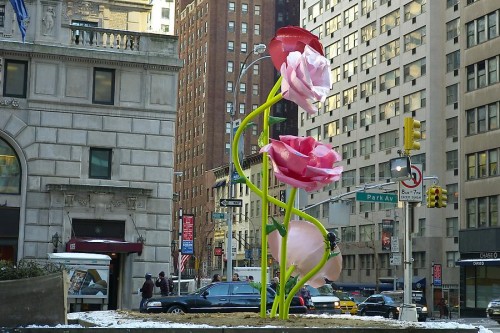 2
2
They’re sculptures by artist, Will Ryman, whose gallery
arranged for the Park Ave. display from Jan through May.
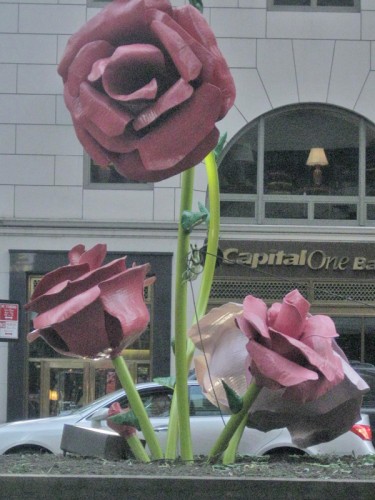 4
4
Several street corners from 57th St. thru 67th St. have different roses.
Some that lay on their side, some that stand up.
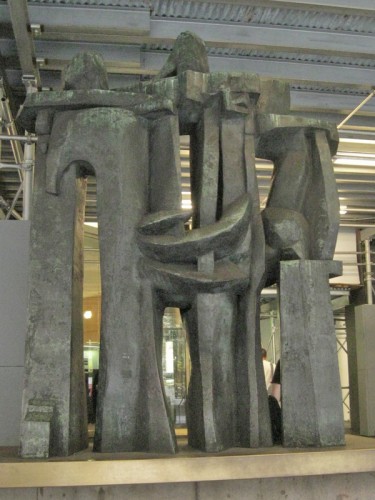 1
1
Down town, on 32nd Street and Park Avenue, there’s a big, stone statue
that is covered by a construction site’s scaffolding. You can only notice the
sculpture if you’re walking past it. Even then, you have to pay attention.
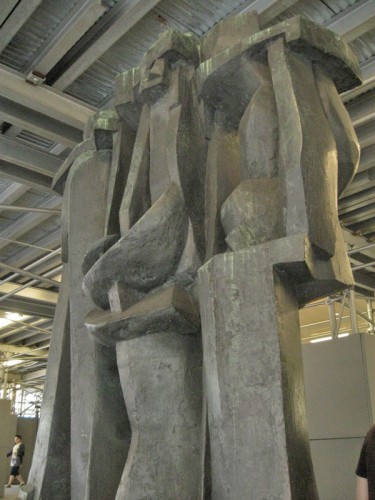 2
2
I took these pictures when it was gray and raining out.
At least, the sculpture stayed dry.
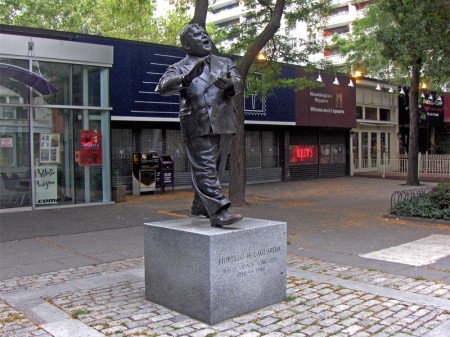
Just outside of Washingon Square Park there’s a mall of a street
filled with small shops and restaurants, LaGuardia Place. Among and
in front of theses shops is a statue of Fiorella LaGuardia, the mayor of
New York from 1934 to 1945. The statue is by sculptor Neil Estern.
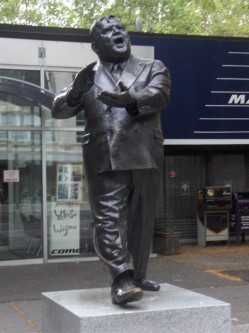
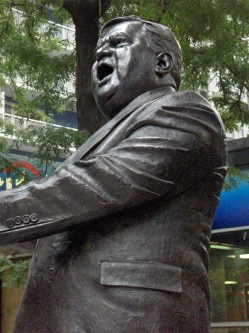
LaGuardia was that he read the Hearst comic strips, “Puck, the comic weekly,”
on Sundays over the radio. An odd little fact that Chuck McCann told us in
his weekly Sunday kiddee show in NY during the 60′s.
I love this statue. It’s not very large and leads me to think that LaGuardia was a
short guy. I don’t know if that’s true, but that’s an impression I take with me.
Photos &Steve Fisher 03 Jul 2011 07:32 am
Empire 4th
- I thought for July 4th, I’d forego any fireworks and put up some photos of pure Americana, at least my version of Americana. Steve Fisher has been photographing the Empire State Building forever. I’ve hesitated about putting up some of these beautiful photos over the years because I thought it might feel a bit repetitive to you. But this is one my favorite buildings (the Chrysler Building is my favorite), and it caught me off guard the other day. I was on 34th Street and a tourist asked me where the building was. We were about half a block away from it, so I just pointed. For some reason I got a twinge in my heart when I looked up at it. (As I said, I love that building.)
Immediately then and there I knew it was going to be the focus for today’s photo show. So, many thanks to Steve for digging out all these great photos.
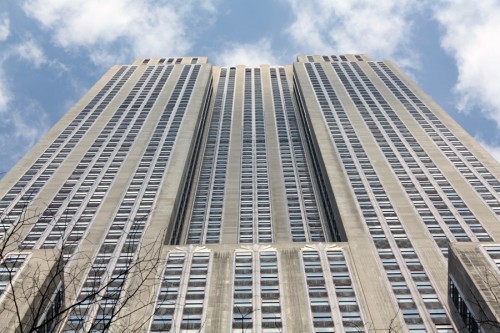 1
1
 7
7
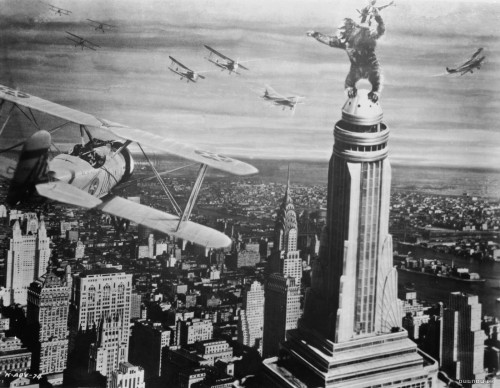 21
21
Tonight TCM is screening the original KING KONG at 8pm.
I guess their programmer was thinking along the same lines as me.
Art Art &Photos 30 Jun 2011 07:05 am
Canemaker’s Back Yard
- This past weekend, Heidi and I spent a lovely quiet time in Bridgehampton at the invitation of John Canemaker and his companion, Joe Kennedy. It made for a very restful and enjoyable time despite the grouchy weather.
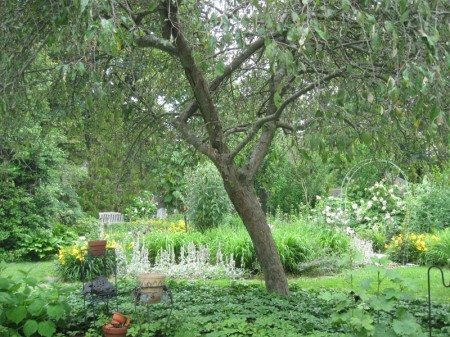
The garden gives you the illusion that it’s larger than it is.
Even walking in it you feel that you could easily get lost in it.
The first dominant site you take with you as you visit the house is the amazing yard and the enormously colorful and tender care Joe and John have taken to cultivate their garden of a back yard. It’s stunningly beautiful. It feels almost as though these plants grew naturally next to each other and happen to take the shape it’s taken. The amount of weeding and nurturing and debugging is left completely behind as you bask in the warm glow of this garden with its variety of flower and shrub. It’s beautiful and peaceful and inviting. I couldn’t help myself over the course of the weekend; I took many walks in the area and sat and enjoyed it. I loved it.
The second thing that captivated me during the visit was a painting John had done. It sat on the wall of the guest room we stayed in. In the first few hours in the house I kept coming back to the painting. I liked it enough that I took out my camera and photographed it. As I did, I realized that there were other smaller paintings in the room, and I found them almost as lovely. There’s no doubt John has been taken with the amazing garden out back, and this has helped to color these fine watercolors.
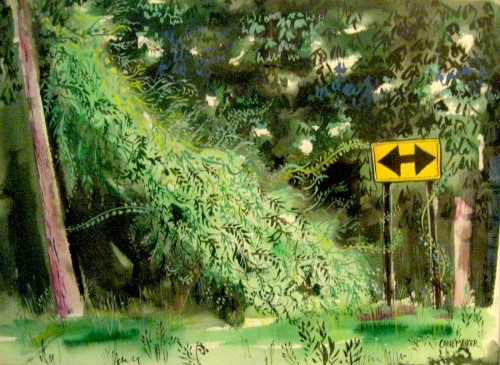
This painting obviously is not from the garden (given the road sign).
However, one can’t help but feel that the life in that garden spills over
into this painting – as it does in all the others.
At some point in the weekend, I asked John if he minded my photographing some of the paintings in the house and posting them on the blog. John, as always, was quite open to anything I wanted to do, so I went about quickly taking some photos. I also intended to mix in pictures from the garden. After all, I see these paintings and the flora as intermingling and working together in a lovely way.
There were some problems. The paintings lost some of their verve when photographed. The delicate colors were lost, and the shape of the pictures altered. (The lens of the camera seems to have slightly distorted the frames of the images.) I saw the pictures in some way influenced by Mary Blair’s work, but John took her colors and softened them. (The brashness of Blair’s work has always bothered me.) In the end, I found myself adjusting the pictures slightly to try to give them a bit of the feel of the originals, but I’m not sure I’ve succeeded. However, better you should get to see these images than none. My apologies to John.
So, I hope you enjoy the quick tour.
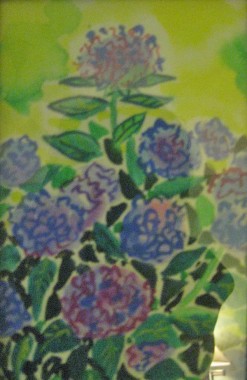
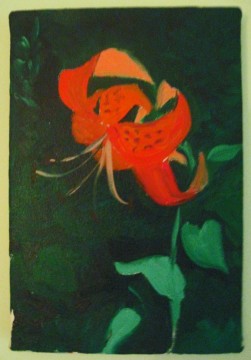
Two other smaller pictures that were in the guest room.
.
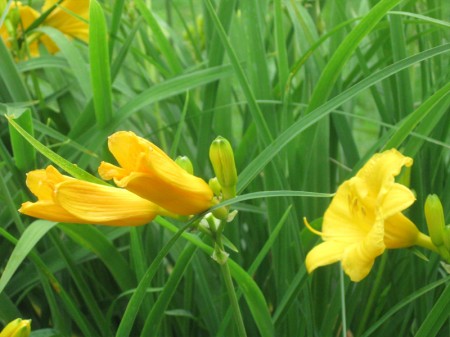
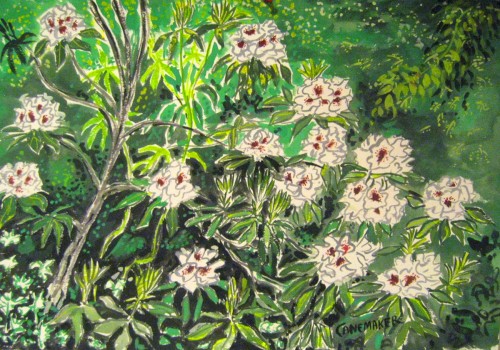
One of the larger paintings John had in his office, downstairs.
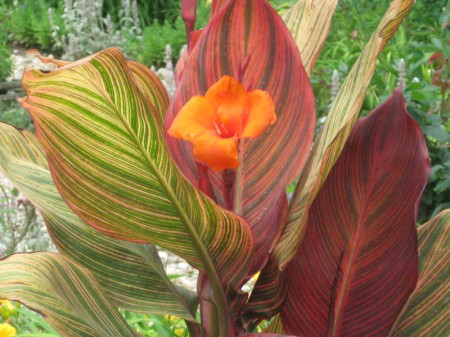
A beautiful flower that opened the day we arrived.
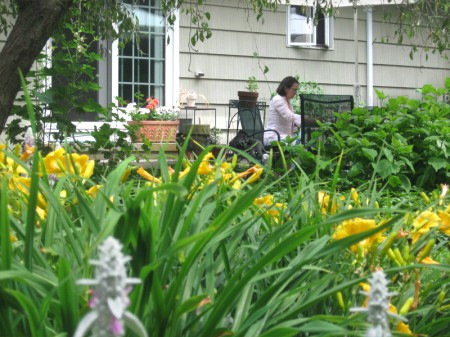
Heidi sitting on the porch just to the front of the garden.
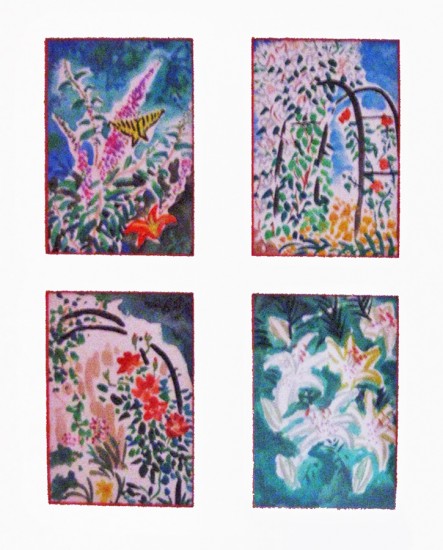
John has done many small quickly sketched watercolors.
Here, you can really feel the distortion of the camera’s lens.
Again, my apologies to John.
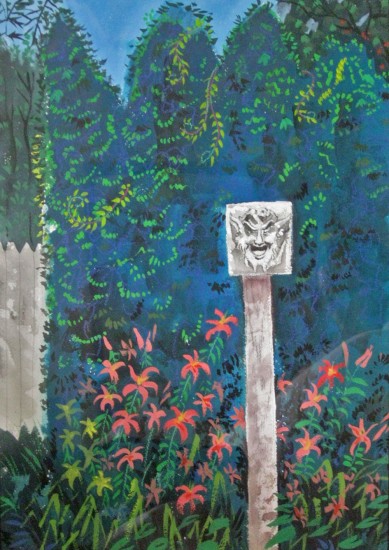
I had a hard time photographing this one.
The reflections in the picture frame’s glass was difficult to avoid.
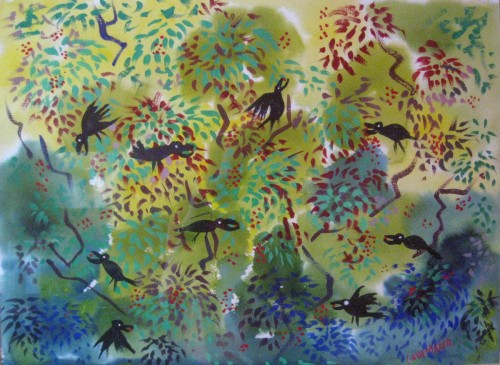
Another painting that just totally caught my attention.

Finally, a lovely little statue sitting just off the porch.
It’s a stone rabbit that once belonged to Bill Tytla.
Adrienne Tytla, Bill’s widow gave it to John as a gift.
Many thanks to John Canemaker and Joe Kennedy for a lovely weekend and all the wonderful inspiration, not only in the paintings but in the garden, as well. It was more than a small retreat.
Photos &Steve Fisher 26 Jun 2011 07:35 am
Sunday Photo Growth
- Steve Fisher had sent me the following three photos over the last year or so.
This week they ended up in the NY Times.
First this one, then this one.
He took the pictures in Queens, an overgrown street lamp being swallowed by a fern.
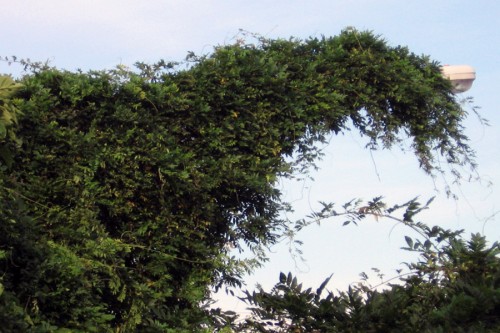 1
1
Congratulations are in order. Steve’s photos always belong in the NYTimes.
I’m glad to post them, even when they don’t make it to that paper.
Here are some other recent photos Steve took of alternate local fauna.
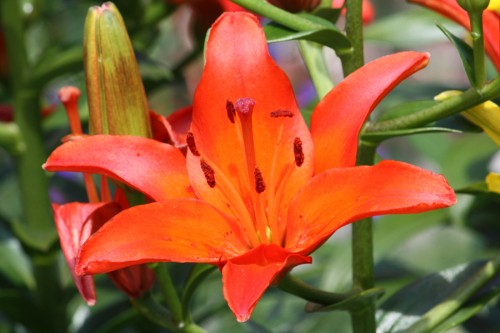 1
1
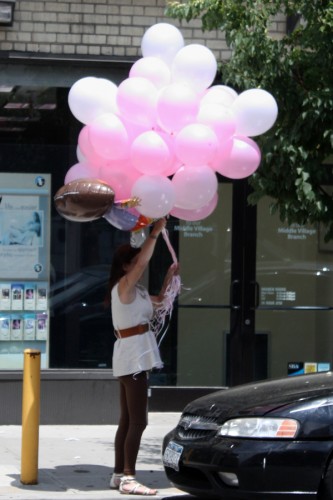 10
10
And just for good measure we have the
ballooons to celebrate.
.
They’re all beautiful, and they’re all appropriate now that we’ve entered the first days of Summer.
Photos 19 Jun 2011 06:53 am
Little Koreatown
- This weekend the subways have been averted from their normal route, and I found it easier to walk six blocks to take something more direct. As it happens, this meant I had to walk through KoreaTown. The is really just a one block area midtown on 32nd Street between Fifth and Sixth Avenues.
In the evening, the area is filled with people all dressed up and ready to party. There are lots of places to eat and club and a lot of Karioke bars. In the morning, (when these pictures were taken) everything looks just this side of seedy.
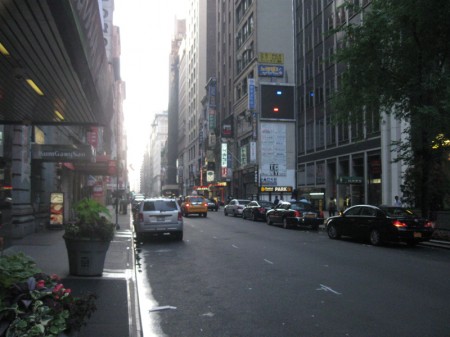 1
1looking across 32nd Street from the vantage point of Sixth Avenue.
.
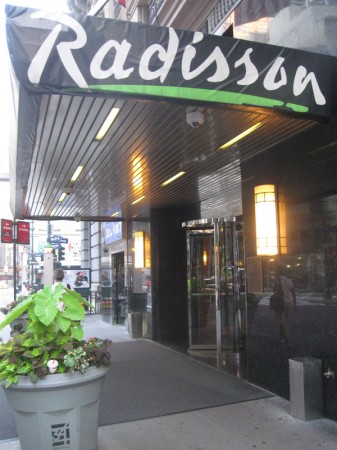 2
2The Radisson Hotel. Always busy, lots of people going in and out.
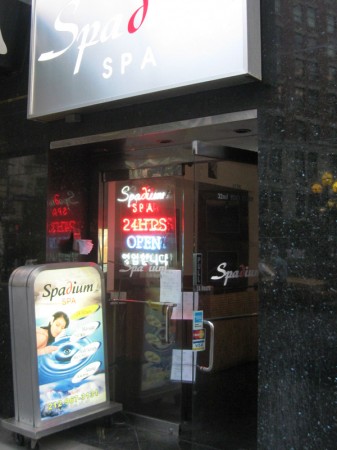 3
3
Just next door to the Radisson is
the Spadium. Looks refreshing.
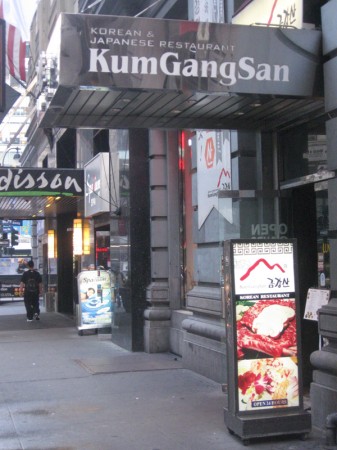 4
4
And next door to that is what appears to be
one of the finer restaurants on the block.
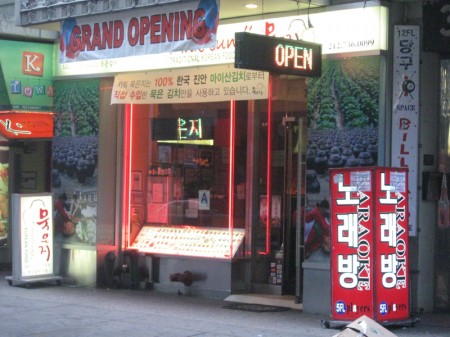 5
5
This is more the average fare – just across the street.
 6
6
A display outside one store gives
you an idea of the treats inside.
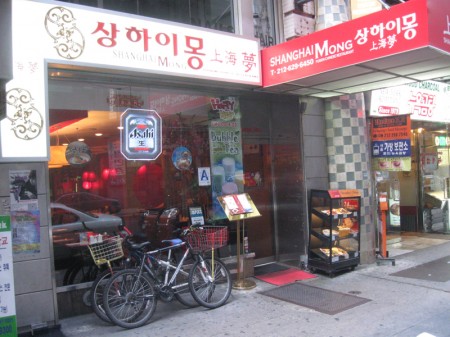 7
7
Though you can see that they all start to blend in together . . .
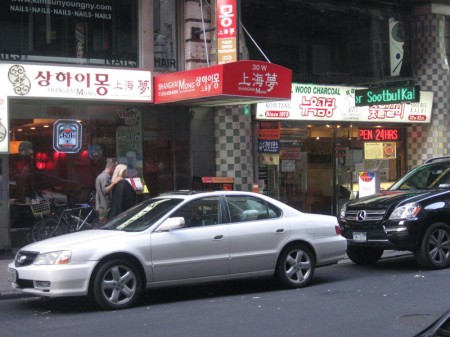 8
8
. . . at least for the uninitiated.
Lots of Bar BQ.
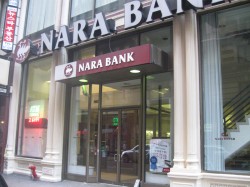
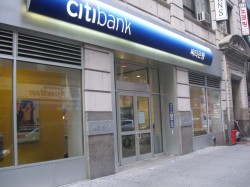
Nara Bank sits alongside CitiBank.
I have a feeling Nara is more popular in the area.
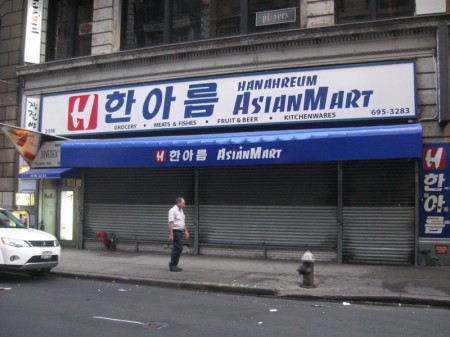 11
11
There’s a mart so you can bring groceries home with you.
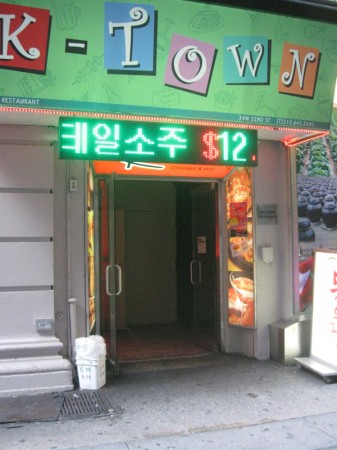 12
12
K-Town seems to be a club for the
young at heart.
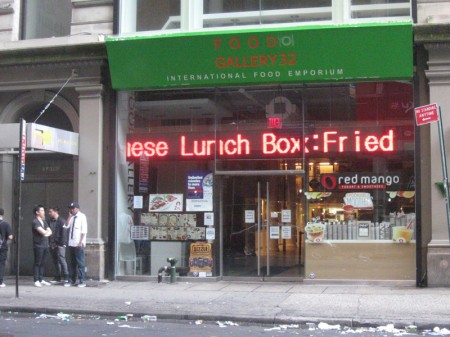 13
13
The lit sign is constantly moving across the store’s window.
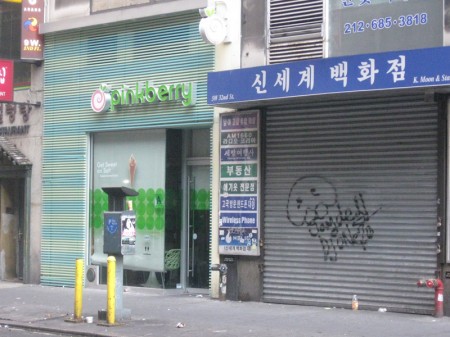 14
14
There’s always room for Yogurt desserts even in Koreatown.
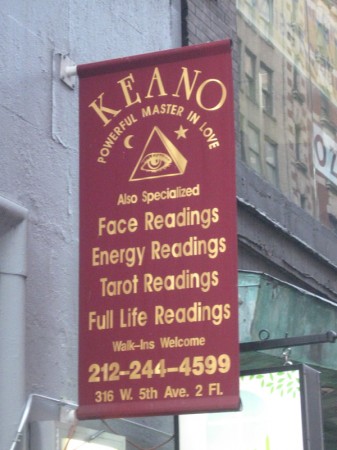 15
15
Of course, no trip to Koreatown would be complete
without a good face reading.
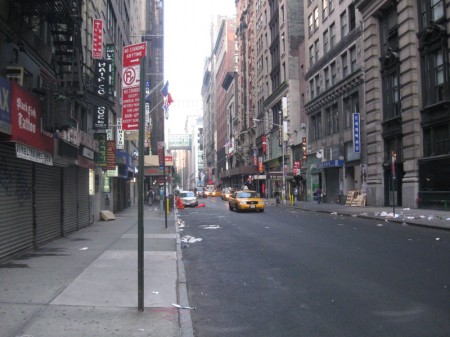 16
16
Looking up 32nd Street from Fifth Avenue.
A lot packed into one city block.
Photos &repeated posts 12 Jun 2011 07:00 am
Recap – Manhole Sunday Photos
Back in August 2007 I put this photo essay together. I was thinking of it this morning and decided to post it again for those who missed it or don’t remember it.
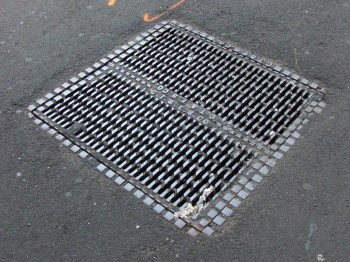 When I was in the sixth grade, I had an extra-ordinary teacher who left me with a lot of memories. One of them was his reading of Edgar Allan Poe’s short story “The Casque of Amontillado,” which chilled us all to the bone as we sat in those little student desks absorbed and thrilled and forevermore fans of Poe.
When I was in the sixth grade, I had an extra-ordinary teacher who left me with a lot of memories. One of them was his reading of Edgar Allan Poe’s short story “The Casque of Amontillado,” which chilled us all to the bone as we sat in those little student desks absorbed and thrilled and forevermore fans of Poe.
Another memory was his asking us all if we knew why manhole covers were round. After a number of stupid guesses, we were told the reason – any other shape would allow the covers to fall into the hole. If they were squared or triangular, they could be maneuvered onto their side until they fell in. Round objects wouldn’t fall.
He also told us that manhole covers in NYC were like snowflakes – no two were alike. This I found hard to believe until I started looking. He was right; they were all different in design. Markedly different in design. I looked for years and thumbed my way through many books admiring the designs I found.
Times have changed. Now they come in only a couple of designs.
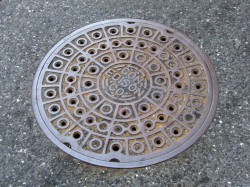 _
_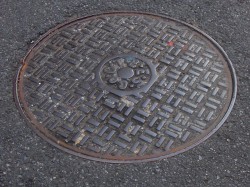
Con Edison is now the primary user for manhole covers, and they seem, these days, to have boiled down to four basic designs. See the two above and the two below.
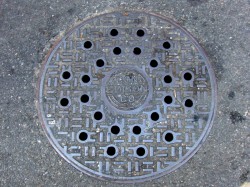 _
_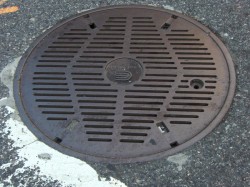
(Click any image to enlarge.)
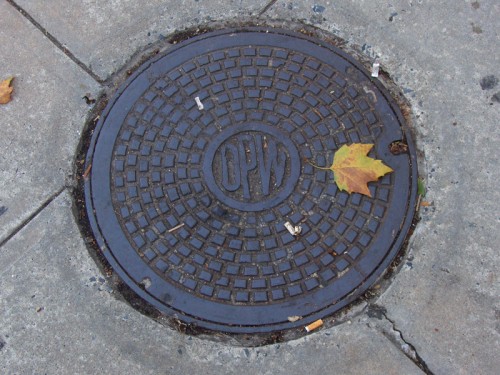
The Department of Public Works features this handy little design. I like its simplicity very much. the color also makes it unique.
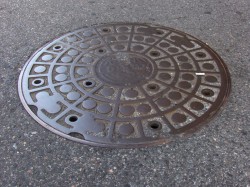 _
_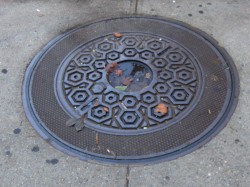
Above left you can see an older model that is wearing down. Parts of the design are blending into other parts almost making a new shape. Above right you see an interesting model. There’s a cover within a cover. The smaller model seems to fit within the larger model, and both can be pulled out. Very interesting. There were three or four of these in the same area around 23rd Street.
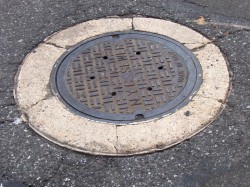 _
_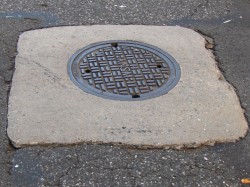
These manhole covers have been fitted into what were obviously larger spaces.
The concrete circle, above left, fills in for an earlier, larger model manhole cover.
Above right, you see a round cover in what was once a square hole.
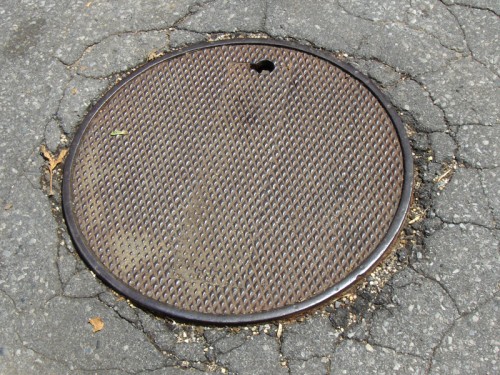
The busy minimalism of this design works very well with the cracked asphalt around it.
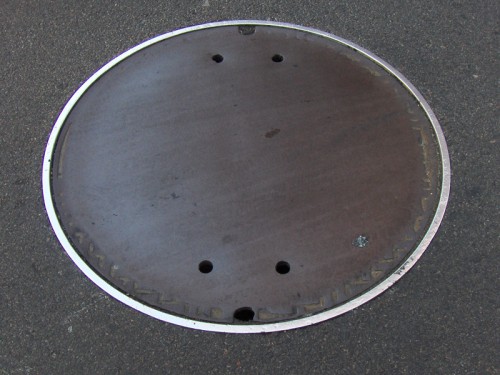
Here we have an interesting model. No design. I guess some would say that that’s
a design in its own right.
If you look on line, you’ll find a lot of information and photos of manhole covers. It’s amazing how big an industry is manhole cover watching. There are many books on the subject, many websites and lots of photographers who specialize in it. I have to direct you to one Roland Muhler. His work is stunning. I’ve posted three of his NYC photos just below. He has many international manhole covers on his site.
Another site which gives a lot of attention to manhole covers is Manhole Covers etc. The site is subtitled: “I’ve been looking down so long, I don’t know which way looks up.” Here you’ll find some history, links and photos from across the US as well as around the world.
Through this site I found a Russian site called Sewers of the World, Unite. There’s plenty of information and links here as well as some excellent photos. The images below are Russian designs from this site.
On the site, the history of sanitary sewers, I found this document (pictured to the right) 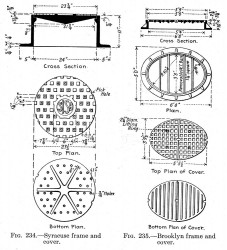 which gives a good view of a plan for some manhole covers. One cover is designed for Syracuse and another for Brooklyn.
which gives a good view of a plan for some manhole covers. One cover is designed for Syracuse and another for Brooklyn.
I also learned in my small amount of research that most of the covers done for NY’s manholes are made in India. I imagine the shipping charges would be enormous.
I presume that the manhole covers are now made of steel whereas they originally must have been molded of iron (and which would have broken when dropped.) I also learned that the sewers once had a hard glass built into the sidewalk openings so that light could enter. Pre electricity must have made working below ground difficult.
I should say more difficult. It’s not a job I’d like.
Today, I received this note from Steve Fisher:
- Michael: As I just stated on your splog, I thought your essay was terrific. I, too, did not know the subject had such a following. Coincidentally, in the same year as your original posting, I was working on a photo book of snaps that I had taken while in India in 2005. I came across a manhole cover around the block from where I live on which was written, much to my surprise, “MADE IN INDIA.†That was the first time I ever really took notice of manhole covers and then learned, too, that many were made there, an early example of out-sourcing. It became a natural for the cover photo and title for my little book. Since then, I am always on the lookout for them. While in Italy in 2008, I took one in Ron’s hometown. Currently, I am working on a photo book of a children’s story, “The Adventures of Tomaso, the Rollaway Sicilian Tomato,†and I am using the image there. Thought you might like to see them. Steve.
